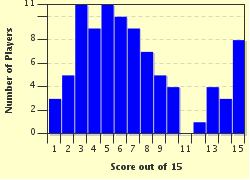Quiz Answer Key and Fun Facts
1. Who was the designer behind the legendary Supermarine Spitfire, one of the most famous fighter aircraft of WWII?
2. Which German fighter ace of the First World War became the chief designer at Arado, creating the Ar.234 'Blitz', the world's first operational jet bomber?
3. Who created a whole series of classic British fighters at Hawker Aircraft, including the Hurricane, Typhoon and Tempest?
4. Who headed the design team that created the British Mosquito, the 'Wooden Wonder' that was one of the most versatile aircraft of WWII?
5. What was the surname of Siegfried and Walter, the twin brothers who at Heinkel were responsible for the He.111 - the workhorse of the Luftwaffe's bomber force?
6. Who was the designer behind the most famous Japanese warplane of the war: the Mitsubishi A6M 'Zero'?
7. Willi Messershmitt did not actually design the Me.109 fighter, the most mass-produced aircraft of the war.
8. Which legend of American aircraft design was responsible for the Lockheed P-38 Lightning?
9. Stalin said that the 'Sturmovik' was as essential to the Red Air Force as "air and bread". Who designed this most famous Russian ground-attack bomber that helped to turn the tide of the German invasion of the Soviet Union?
10. Ernst Zindel designed one of the most famous airliners in the world, which was to earn equal fame as a transport aircraft during WWII. Which aircraft was it?
11. Born in Georgia, trained in France, but employed in the USA as an American citizen, which designer was the genius behind the P-47 Thunderbolt and the first generation of Republic jet fighters?
12. The top Allied ace, Ivan Kozhedub, shot down 62 enemy aircraft. He scored all his victories flying fighters designed by which stalwart of Russian aeronautical design?
13. George Carter was the chief designer behind the Gloster Meteor, the only Allied jet to see operational service in WWII. To which English pioneer of turbojet technology was Carter indebted in the evolution of his design?
14. Which Dutch-American designer was responsible for the C-64 Norseman, a versatile light transport aircraft that earned macabre notoriety as the type in which band leader Glenn Miller went missing over the English Channel in October 1944?
15. Famous as the inventor of the 'bouncing bomb' that was used in the Dambusters Raid of 1943, Barnes Wallis was already a noted British engineer who had pioneered the use of geodetic construction in aircraft design. Which of these WWII bombers incorporated this technique?
Source: Author
Plumbus
This quiz was reviewed by FunTrivia editor
bloomsby before going online.
Any errors found in FunTrivia content are routinely corrected through our feedback system.

